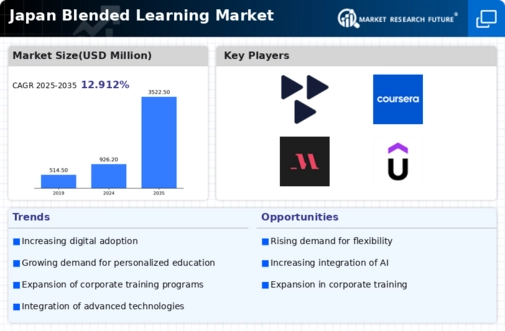Increased Focus on Lifelong Learning
In Japan, there is an increasing focus on lifelong learning, which is driving the growth of the blended learning market. As individuals seek to enhance their skills and knowledge throughout their lives, educational institutions are adapting their offerings to meet this demand. Data reveals that around 40% of adult learners in Japan are engaging in blended learning programs to pursue personal and professional development. This trend reflects a cultural shift towards valuing continuous education, thereby creating opportunities for the blended learning market to expand its reach and impact across various demographics.
Advancements in Educational Technology
Technological advancements play a pivotal role in shaping the blended learning market in Japan. The proliferation of high-speed internet and the widespread availability of digital devices facilitate seamless access to online learning resources. Reports suggest that over 70% of Japanese students utilize smartphones or tablets for educational purposes, underscoring the importance of technology in modern learning environments. Furthermore, innovations such as artificial intelligence and virtual reality are enhancing the interactivity and effectiveness of blended learning programs. As educational institutions increasingly invest in these technologies, the blended learning market is likely to expand, offering more dynamic and engaging learning experiences.
Corporate Training and Upskilling Initiatives
The blended learning market in Japan is significantly influenced by the growing emphasis on corporate training and upskilling initiatives. As companies recognize the need to equip their workforce with relevant skills, many are turning to blended learning solutions that combine online courses with in-person workshops. Recent statistics indicate that approximately 55% of Japanese companies have implemented blended learning strategies to enhance employee development. This trend not only improves workforce competency but also fosters a culture of continuous learning within organizations. Consequently, the blended learning market is expected to thrive as businesses prioritize effective training methodologies.
Rising Demand for Flexible Learning Solutions
The blended learning market in Japan experiences a notable surge in demand for flexible learning solutions. As educational institutions and corporate training programs seek to accommodate diverse learning preferences, the integration of online and face-to-face instruction becomes increasingly appealing. Recent data indicates that approximately 60% of educational institutions in Japan are adopting blended learning methodologies to enhance student engagement and retention. This shift reflects a broader trend towards personalized education, where learners can tailor their experiences to fit their schedules and learning styles. Consequently, the blended learning market is poised for growth as it aligns with the evolving expectations of students and professionals alike.
Government Initiatives Promoting Digital Literacy
The blended learning market in Japan benefits from government initiatives aimed at promoting digital literacy among citizens. The Japanese government has recognized the importance of equipping individuals with the necessary skills to thrive in a digital economy. Recent policies have been introduced to enhance access to digital education, with a focus on integrating technology into traditional learning environments. As a result, educational institutions are increasingly adopting blended learning approaches to align with these initiatives. This supportive regulatory framework is likely to bolster the blended learning market, fostering an environment conducive to innovation and growth.















Leave a Comment